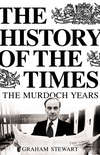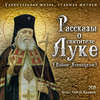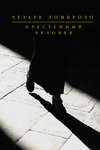Читать книгу: «The History of the Times: The Murdoch Years», страница 5
V
Richard Searby believed Rupert Murdoch’s desire to own The Times was deep-seated and stretched back to the splendid engraved inkwell that the paper’s owner, Lord Northcliffe, had presented to his father.94 At Geelong Grammar, a boarding school labouring under the tag ‘the Eton of Australia’, the boys mocked the young Rupert with his father’s nickname, ‘Lord Southcliffe’. In fact it was his first name, Keith, that Rupert shared with his father.
The friendship between Northcliffe and Keith Murdoch had been forged during the First World War. In 1915 while employed by one of the news agencies, Keith Murdoch had been sent out to cover the Dardanelles campaign where Australian and New Zealand (Anzac) soldiers were suffering heavy casualties. He quickly surmised that the senior command was incompetent and that heroic Anzac troops were being let down by their British counterparts. In fact, he was not on the front line and much of his information came from a dissatisfied reporter from the London Daily Telegraph. But if his sources were weak his readership was focused. His report landed on the desk of the Australian Prime Minister and, on reaching London, Keith Murdoch went to The Times with his account. Northcliffe, the paper’s editorially interfering proprietor, read it and told the driven Australian journalist to pass it to the Prime Minister. Asquith promptly circulated it to his Cabinet.
The commanding officer, General Sir Ian Hamilton, blamed his subsequent removal on Murdoch’s coloured account. The Anzacs’ withdrawal from the campaign also came to be seen as stemming from what had been written. Keith Murdoch’s version would eventually be summarized by his admiring son: ‘it may not have been fair, but it changed history’.95 In the year the son bought The Times, he co-financed a film, Gallipoli, starring Mel Gibson, in which effete British commanders casually sacrificed the lives of courageous anti-Establishment Australians. Given a choice between truth and legend, the son continued to promote the legend.
From the moment of Keith Murdoch’s Dardanelles scoop, he had the attention and support of Lord Northcliffe. The owner of The Times became a mentor for the motivated Australian, inspiring him and including him in his influential social circle. And Murdoch learned a good deal from the man who had done so much to create the mass-appeal ‘new journalism’, launching new titles and rejuvenating old ones like The Times. When Murdoch struck out on his own, taking up the editorship of Australia’s Melbourne Herald, Northcliffe even went over there to sing his praises. The Herald’s directors soon had cause to join in: circulation rose dramatically and its editor joined its management board, buying other papers and a new medium of enormous potential – a radio station. Growth would be fuelled by acquisition, creating a business empire in a country in which the print media was entirely localized. It was also a route to making enemies who believed Keith (from 1933, Sir Keith) Murdoch’s expansionist strategy not only gave the Herald and Weekly Times Group too much financial clout but also made its managing director a kingmaker in Australian politics as well. The Herald Group’s competitors were especially dismayed when with the outbreak of the Second World War he was appointed Australia’s director-general of information. The role of state censor was certainly not in keeping with the role he had played in the previous conflict. But when, in 1941, ten-year-old Keith Rupert Murdoch arrived at boarding school, it was to discover to his surprise that it was his father’s crusade to bolster the power of the press that was often looked at with mistrust and apprehension.
Though he showed little interest in Geelong’s emphasis on team sports, Rupert Murdoch’s childhood had been predominately spent outdoors with his three sisters riding and snaring (Rupert persuaded his sisters to skin the unfortunate rodents for a modest fee while he sold on the pelts at a larger mark-up). Home was his parents’ ninety-acre estate, Cruden Farm, thirty miles south of Melbourne. The house itself was extended over the years and by the time Rupert was growing up there it resembled the sort of colonnaded colonial residence more generally associated with Virginian old money. But rather than be overexposed to its creature comforts, Rupert spent his evenings between the ages of eight and sixteen in a hut in the grounds. His mother thought it would be good for him.96
Cruden was named after the small Aberdeenshire fishing village from which Rupert Murdoch’s grandfather, the Revd Patrick Murdoch, had lived and preached. A Minister in the principled and unyielding Calvinism of the Free Church of Scotland, the Revd Murdoch had in 1884 transferred his mission to the fast-expanding metropolis of Melbourne. Widely admired, by 1905 he had risen to the church’s highest position in the country – moderator of the General Assembly of Australia. The grandfather on his mother’s side provided young Rupert with a contrasting influence: Rupert Greene was an affable half-Irish, free-spirited gambling man. Not surprisingly, commentators came to see Rupert Murdoch as, in some ways, a composite of the two.
In 1950 Murdoch went up to Oxford University. For the most part he enjoyed student life there and later became a generous benefactor of his college, Worcester. But at the time, and despite the efforts of such eminent tutors as Asa Briggs, it was not his Philosophy, Politics and Economics degree course that held his attention. At the Geelong school debating society, he had espoused radical and frequently socialist views. He maintained this stance at Oxford, often attending Union debates where bestrode confidently the young Tory matador, Rees-Mogg of Balliol. Murdoch, however, chose to stand for office in the university Labour Club. The club’s president, the young Gerald Kaufman, had other ideas, and had him disqualified for illegally soliciting votes (canvassing being – technically – forbidden). Some thought it was Murdoch who was indulging in gesture politics. He kept a bust of Lenin in his rooms, but they were among the finest in college. He was also one of the few students committed to the triumph of the proletariat to own, in his final year, a car in early 1950s Oxford. He had an eclectic circle of friends in a whimsical philosophical society he joined named after Voltaire. Cherwell described him as ‘turbulent, travelled and twenty-one, he is known … as a brilliant betting man with that individual Billingsgate touch. He manages Cherwell publicity in his spare time.’97 Relegated to even sparer time were his studies and in 1953 he went down with a third-class degree.
On coming down, he got his first taste of Fleet Street as a junior sub at the Daily Express. The pride of Beaverbrook’s titles, the Express was at that time close to the summit of its prestige and popularity. Edward Pickering found time to keep a paternal eye on Sir Keith’s son as he toiled away on the subs desk. Indeed, Pickering assumed the mentor’s role for Rupert Murdoch that Northcliffe had played for his father. And the young journalist appreciated the training, retaining throughout his career the highest regard for the man he would ultimately make executive vice-chairman of Times Newspapers.
In September 1953, Murdoch returned to Australia. But it was not the homecoming of which he had once dreamed. Sir Keith had died the previous year while his son was still up at Oxford. It was a terrible blow. ‘My father was always a model for me,’ Murdoch later said. ‘He died when I was twenty-one, but I had idolized him.’98 And the son had learned something else from his father’s experience: Sir Keith had built up a newspaper empire, but as a manager, not an owner. After death duties had taken a sizeable claim, the money left for his widow Lady (later Dame) Elisabeth, son and three daughters was held in the family holding company, Cruden Investments. The Herald Group persuaded Lady Elisabeth to sell them the Murdoch half-share in the Brisbane Courier-Mail on terms that proved highly favourable to the Herald Group. Thus the only proprietorship left for Rupert Murdoch to inherit was a controlling interest in News Limited, owner of a single by no means secure daily, the Adelaide News – which was not even the biggest paper in Adelaide – and its sister title, the Sunday Mail. The immediate response of the Herald Group was to try and strip him of it. On failing to persuade Lady Elisabeth to sell them the Murdoch stake in News Limited, they announced their intention to drive the Adelaide News out of business. Sir Keith had helped make the Herald Group the most important media company in Australia. Its treatment of his family on the morrow of his death caused tremendous acrimony. And it instilled in the son an important lesson about where power lay. He would follow in his father’s footsteps, but with one crucial difference – he was determined to own the papers he built up.
The first objective was to see off the Herald Group’s assault on the Adelaide News and Sunday Mail. The attack was repulsed and News Limited became the basis of Rupert Murdoch’s acquisitions fund. Within two years of taking the helm he saw its net assets double. After purchasing a Melbourne women’s magazine, the loss-making Perth Sunday Times became his first newspaper acquisition in 1956, when he was still only twenty-four. He transformed its sales but kept its sensationalist reporting. The purchase of other small local papers followed. Then he bid successfully for one of the two licences for Adelaide’s first television channels. His Channel 9 beat the rival Channel 7 to be first on the air and started generating enough revenue to finance far grander dreams of expansion. Sydney’s newspaper market was a virtual duopoly of the Fairfax and Packer families but in 1960 Murdoch got a foot in the door when Fairfax sold him the Mirror, a downmarket paper which had become something of an embarrassment to the company and which when sold, it was imagined, would be less of a threat if owned by an outsider like Murdoch than by a more direct rival. Instead, the result was a no-holes-barred circulation war in which Sydney’s tradition of sensationalist reporting was surpassed.
In 1964 Murdoch launched his first new title. Based in the capital, Canberra, The Australian became the country’s only truly national newspaper. It was also a serious-minded broadsheet, committed to political analysis and in-depth reporting. In other words, it was a departure from its owner’s previous projects. Maxwell Newton, The Australian’s editor, recalled that on its first night Murdoch told him, ‘“Well, I’ve got where I am by some pretty tough and pretty larrikin methods … but I’ve got there. And now,” he said, “what I want to do – I want to be able to produce a newspaper that my father would have been proud of.”’99 He stuck with the paper ever after, despite its inability to return a profit.
In 1969, Murdoch made the great leap, breaking into the British market with a newspaper far removed from his product in Canberra. He had originally wanted to take control of the Daily Mirror, but purchasing sufficient shares proved impossible. The News of the World was a popular Sunday institution, long known as the ‘News of the Screws’ because of its stories about defrocked vicars and low goings-on in high places (or just low places if it was a slow news day). With six million copies sold each Sunday (down from a peak of over eight million in 1950), the raucous and right-wing publication had the largest circulation of any newspaper in Britain. But by 1968 its Carr family proprietors, giving the outward impression of ennui, found themselves fragmented and receiving the unwelcome attention of Robert Maxwell. In order to prevent Maxwell buying a third of their company’s shares, the Carrs opted to sell a 40 per cent stake to Murdoch. This seemed the best policy since, although the thirty-eight-year-old Australian would become managing director, he had promised that he would not seek to increase further his share and that Sir William Carr – or, in time, another member of his family – would continue to be chairman of the company. Within six months of the deal going through, Murdoch duly increased his share, entrenched his control of the paper and forced Sir William, incapacitated by illness, to resign. Murdoch then put himself forward as chairman. He regarded this as a matter of business sense. Others called it sharp practice.
It was the trade unions that provided Murdoch with his greatest coup. Maxwell, having been thwarted in his attempt to acquire the News of the World, hoped to buy the ailing Sun from the Daily Mirror’s owners, IPC. He would maintain the Sun’s left-leaning politics and would not let it challenge the Mirror directly for dominance. Delighted, IPC agreed generous terms of sale. But Maxwell also made it clear that in taking on a loss-making paper he would have to cut jobs and costs. The unions objected to this, and Hugh Cudlipp, IPC’s chairman, feared it might trigger a wave of union militancy that would disrupt production of the company’s highly profitable Mirror. Cudlipp had fathered the Sun in 1964 as a middle-market broadsheet (it replaced the defunct trade union-backed Daily Herald bought by IPC three years earlier) and did not want to contemplate infanticide. So he sold it for the trivial sum of £500,000 (of which only £50,000 was a down payment) to Murdoch, a man who – compared to Maxwell or the alternative of certain death – had the unions’ blessing. Over the next three years, the circulation of Murdoch’s Sun rose from under one million to over three million. The paper’s mix of sauce and sensationalism earned its new owner the sobriquet ‘Dirty Digger’. But more to the point, he now had his cash cow and could plan for expansion accordingly.
Yet Murdoch’s next forays into Fleet Street were unsuccessful. It seemed The Times would never come up for sale – Roy Thomson had pledged as much and was not in apparent need of ready cash. But the future of another illustrious title, the Observer, edited by Gavin Astor’s cousin David, appeared far less certain. In 1976, however, it preferred to sell itself for a mere £1 million to Atlantic Richfield rather than to the downmarket tabloid owner of the Sun and the News of the World. Like Thomson with Times Newspapers, Atlantic Richfield was a company making large profits from oil exploration that talked the language of moral obligation rather than business opportunity (at least until 1981 when it sold the loss-making paper to Tiny Rowland). In 1977, Murdoch’s was one of the raised hands in the crowded bidding for the fallen Beaverbrook empire. The prospect of breathing new life into the once mighty Daily Express, where nearly a quarter of a century earlier he had learned the subeditors’ craft from Edward Pickering, was naturally appealing. But he lost to a higher bid from Trafalgar House who placed a building contractor, Victor Matthews, behind the chairman’s desk of the newly named Express Newspapers.
But by this stage, Murdoch’s News Limited had spread to three continents. His first American acquisitions came in Texas when in 1973 he bought the San Antonio Express and its News sister paper. After a slow start the titles became increasingly profitable. An attempt to launch a rival to the National Enquirer proved unsuccessful but he was not to be put off by temporary reverses (he merely transformed his product into Star, a women’s magazine that by the early eighties returned a $12 million annual profit). The great test of his mettle came in 1976 when Dorothy Schiff sold him the liberal leaning New York Post. He paid $10 million for a paper that was haemorrhaging money, but rather than taking time to regroup he immediately pressed ahead, spending a further $10 million to buy New York magazine and Village Voice.
In the twenty-eight years between his father’s death and his acquisition of The Times, Murdoch had progressed from owning one newspaper in Adelaide to becoming a major presence across the English-speaking world with annual sales of over A$ 1 billion (£485 million). His News Corporation was valued on the Sydney stock exchange at £100 million. It owned half the shares in its British subsidiary, News International (owner of Times Newspapers and the tabloids of News Group Newspapers). The other half of News International’s shares was quoted on the London stock exchange with a value of £35 million. Yet the perceived imperative of keeping personal control had not been squandered in the midst of this expansion. The Murdoch family’s holding company, Cruden Investments, still owned 43 per cent of the parent company.100
Murdoch was able to pursue a policy of aggressive expansion because of the profitability of his London tabloids and by pointing to a proven track record in turning around under-performing titles. It was enough to secure credit from the banks. But his growing band of critics had come to credit him only with debasing the profession of journalism. Aside from his patronage of The Australian (and even here there had been evidence of his interference in editorial policy), he was now held in contempt by those who believed he had built success upon a heap of trash. His titles sensationalized events, trivialized serious issues (when indeed they bothered to report serious issues at all) and frequently allowed their zeal in getting a scoop to overcome questions of taste, fairness and honesty. More than any other, it was Murdoch’s name that had become associated with ‘tabloid journalism’ as a pejorative term.
From November 1970, the Sun sported topless women on its page three. Feminists and arbiters of decency loudly condemned this popular move. In fact, it was not exactly a Fleet Street first: as long ago as 1937 the high-minded Hugh Cudlipp, then editor of the Mirror’s Sunday sister paper, had reproduced a topless damsel chaperoned by the obtuse picture caption ‘a charming springtime study of an apple-tree in full blossom’. Even newspapers owned by such respectable figures as Lord Thomson and edited by William Rees-Mogg were not immune. Five months after the Sun launched its topless page three girls, The Times pictured one of them nude in a full-page advertisement for Fisons’ slimming biscuits (one reader asked whether the paper’s self-regarding 1950s advertising slogan ‘Top People Take The Times’ should be replaced with ‘Topless People Take The Times’; another wrote, ‘I hope this delightful picture has the same effect on The Times’s circulation as it does on mine.’). Although it proved a sell-out issue, it did not, however, start a broadsheet trend. In contrast, page three nudity became synonymous with the Sun. Those who did not believe masscirculation newspapers were the place for entertainment or triviality hated Murdoch’s winning formula every bit as much as a previous generation had chastised Northcliffe for giving the people what they wanted in place of what was thought good for them. In the case of the Sun and the New York Post, Murdoch had indeed taken serious-minded newspapers downmarket. But many of his offending newspapers (in particular the News of the World, the Perth Sunday Times and the Sydney Daily Mirror) had been peddling titillation, half-truth and questionable journalistic standards long before his arrival on the scene. But the increasing size not only of headlines – now often involving a comic pun – but also graphic photographs certainly made their wares more pervasive and intrusive.
Murdoch was not interested in the critics of his tabloids. In his eyes they were cultural snobs, seeking to enforce their own tastes on millions of people whose lives were lived in conditions about which the arbiters of taste demonstrated scant concern or understanding. Papers like the Sun and the New York Post were responding to a need, reflecting what their readers wanted to unwind with in the course of what was otherwise a day of toil. But Murdoch went further in the defence of his titles. They were not just a form of cheap entertainment; they were genuine upholders of a fearless fourth estate. What the cultural establishment branded scandal-mongering was, more often, an attempt to hold to account those in public life for their actions – public and private. While the self-righteous broadsheets lazily reported ‘official’ news after it had happened, the popular press regularly created the news in the first place, by uncovering what was actually going on behind the veneer of authorized pronouncement. It was, Murdoch asserted:
not the serious press in America but the muck-rakers, led by Lincoln Steffens and his New York World, who became the permanent opposition and challenged the American trinity of power: big business, big labour and big government. It was not the serious press which first campaigned for the Negro in America. It was the small, obscure newspapers of the Deep South.101
Nor was this a phenomenon of the New World. Having sympathized with the Confederates in the Civil War, zealously advocated the appeasement of Hitler in the 1930s and adopted an understanding attitude towards Stalin in the 1940s, The Times had, in its high-minded way, not always walked with angels.
Yet, it was the social and political comment in Murdoch’s tabloids that many of his critics found the most pernicious aspect of his influence. The proprietor had long since mislaid his bust of Lenin, but not his dislike of the class system, and in the first three general elections of his ownership, the Sun endorsed the Labour Party. But when it came out in support of Margaret Thatcher’s Conservatives for the 1979 election, left and liberal commentators perceived they were now up against a formidable foe that was hooking millions of innocent readers to right-wing policies by pandering to their fears and sugaring the poison with smut and light entertainment. It was as if the Sun had become the opiate of the people. Two headlines in the paper in the months leading up to the 1979 election became legendary: ‘Crisis? What crisis?’ misquoted what the Labour Prime Minister, James Callaghan, had said on returning from a summit in Guadeloupe (although it caught accurately the mood he conveyed) while ‘Winter of Discontent’ soon became the recognized description of the period of industrial strife.102 In fact the Richard III reference had actually been made by Callaghan in a television interview two months earlier, but it was the Sun’s usage that gave it wider currency. Despite the evidence – as Callaghan acknowledged – that there was a cultural sea change underway among the electorate in favour of Mrs Thatcher, discontented figures on the left began to believe that their arguments had been defeated not in a reasoned debate but by the cheap headlines of Murdoch’s newspapers and their equivalents on the advertising hoardings hired by Saatchi & Saatchi. Given that Murdoch was known to interfere in the line his newspapers took, it was reasonable to assume the right-wing slant was all his doing. In fact, the extent of the Sun’s partisan support for Mrs Thatcher was far more a case of its editor, Larry Lamb, dictating the paper’s politics to the proprietor. Murdoch’s instincts had been far more cautious. But editors were easily dispensable and it was Murdoch who gained the opprobrium, one that got worse the more he came to believe Lamb had made the correct call.
This was the background to Harold Evans’s determination to have legally watertight safeguards against Murdoch’s exercising any editorial interference in The Times and Sunday Times. And there were plenty of journalists on the payroll determined to assert their independent judgment from the first. The profile of Rupert Murdoch that appeared in The Times upon his gaining control of the paper was certainly not effusive. Dan van der Vat described a ‘ruthless entrepreneur … and pioneer of female nudity’ pursuing a strategy of taking his papers ‘down-market to raise circulation’. Murdoch was the owner in the United States of ‘the downmarket Star’ who ‘transformed in the familiar down-market manner’ the New York Post. Scraping the barrel to try and find something positive to say, van der Vat’s profile concluded that The Times and Sunday Times ‘each have the most demanding readership in Britain, and it is a well-known tenet of Mr Murdoch’s philosophy to give the readers what they want’. The leader article, written by Rees-Mogg and entitled ‘The Fifth Proprietorship’, was less keen to find fault. Sketching the previous four owners of the paper, it noted, ‘neither Northcliffe nor Roy Thomson … managed to solve its commercial problems. If Mr Murdoch does resolve those problems he will have achieved something which has defied the masters of his craft.’ In Rees-Mogg’s opinion, the new owner stood ‘somewhere between’ Northcliffe’s ‘editorial genius’ and Thomson’s outlook as ‘a business man’. Murdoch was ‘a newspaper romantic’.103
Less happy with this affair of the heart was the new owner’s wife, Anna. Looking forward to bringing up a young family in New York, she did not want to be uprooted and moved to London, a city in which she had previously had bad experiences (in particular the murder of a friend by kidnappers who mistook the woman for their actual ransom target – Anna herself). The Times, she conceded, was ‘not something that I really want, but if Rupert wants it and it makes him happy I’m sure we’ll sort it out’.104 Nonetheless, for her husband’s fiftieth birthday on 11 March 1981, she presented him with a cake iced with a mock front page of The Times – into which he excitedly plunged the knife.
Начислим
+6
Покупайте книги и получайте бонусы в Литрес, Читай-городе и Буквоеде.
Участвовать в бонусной программе









